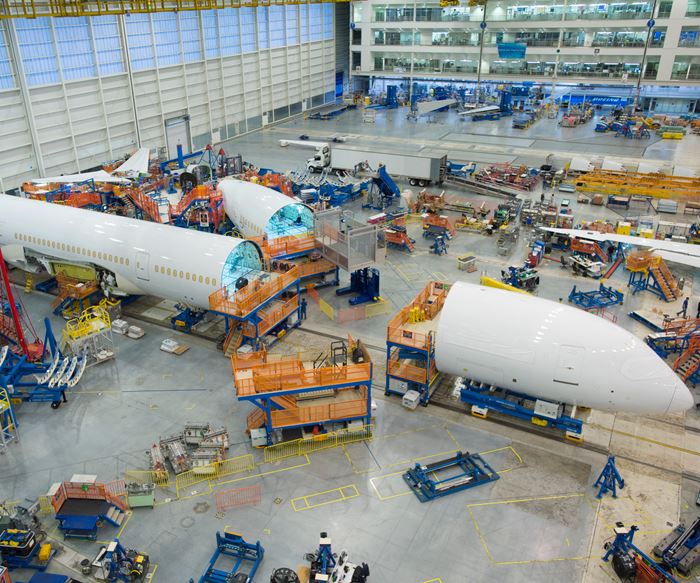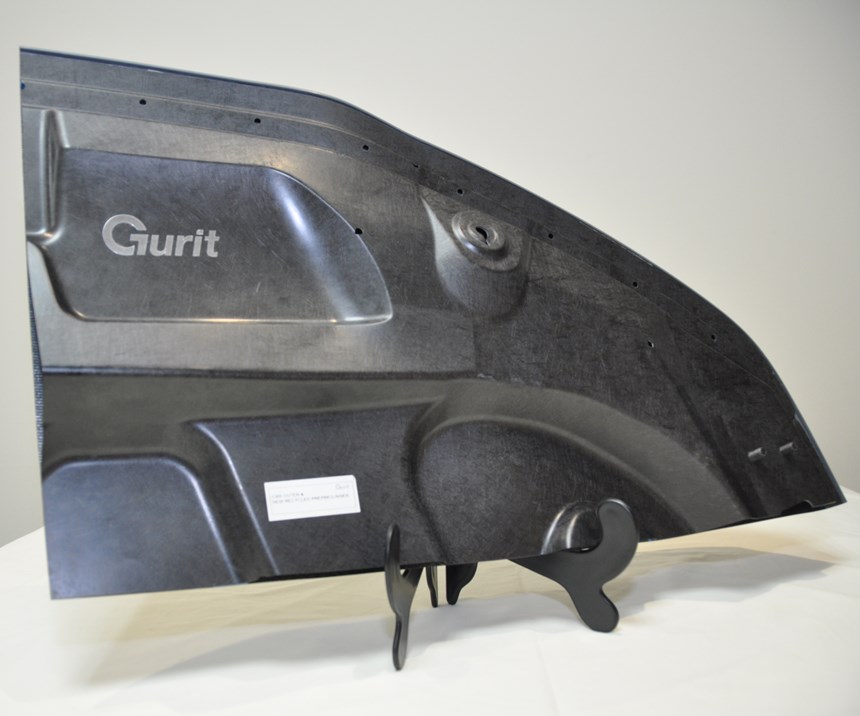Boeing to supply ELG carbon fiber for recycling
Under a five-year agreement, Boeing will supply carbon fiber recycling specialist ELG Carbon Fibre with cured and uncured material from its 777X wing manufacturing facility, as well as other locations.
The Boeing Co. (Seattle, WA, US) and carbon fiber recycling specialist ELG Carbon Fibre Ltd. (Coseley, UK) announced on Dec. 5 that they have signed a five-year agreement whereby Boeing will supply to ELG cured and uncured carbon fiber composites that will be converted by ELG into secondary products for use in other composites manufacturing applications.
The cured and uncured carbon fiber waste will come from 11 Boeing composites manufacturing operations, including the 777X Composites Wing Center in Everett, WA, Boeing South Carolina in Charleston, SC, US, and eight other Boeing US sites involved in manufacturing commercial airplanes, rotorcraft and other products. The agreement also includes carbon fiber composites waste from Boeing’s composites fabrication operations in Melbourne, Australia.
Boeing says it provided about 380,000 pounds of waste material during the 18-month pilot project, begun in March 2017. Under the new agreement, the company anticipates the initial volume will be about 1 million lb a year from its Puget Sound sites. That amount is expected to double over the next five years as excess material is collected from all of Boeing’s composite manufacturing sites. This will support Boeing’s goal to reduce the amount of solid waste going to landfills 20 percent by 2025.
The agreement is significant as it marks the first formal material supply relationship between a major aircraft OEM and a carbon fiber recycler. Frazer Barnes, managing director of ELG, says his company has been working with Boeing for four years to evaluate and characterize the properties of materials derived from Boeing’s carbon fiber waste. “We’ve evaluated mechanical properties — tension, compression, flexure, shear — with a variety of polymers (epoxy, PP, PA6, PA66 and PPS) and processes (liquid compression molding, prepreg compression molding, thermoplastic compression molding),” he says. “We’ve then gone in to look at durability aspects — fiber/resin interfacial strength, fatigue, fluid exposure, with the fatigue and exposure work focused on the epoxy laminates.”
ELG, he says, expects to integrate the Boeing waste into carbon fiber nonwoven products ELG manufactures, as well as chopped carbon fiber for use in thermoplastics compounding, both under the CARBISO trade name.
Although the technology to recycle cured and uncured carbon fiber materials has existed for several years, the composites recycling industry is still in the nascent stages of developing markets for materials it produces from recyclate. Barnes also notes that growth has been limited by concern among some potential users who desire supply stability: “One of the things that most concerns the end user is supply chain security. Obviously, this agreement goes along way toward establishing that security.”
Boeing, for its part, is eager to make sure that its composites manufacturing operations are as efficient as possible. Kevin Bartelson, senior director of 777 and 777X wing programs at Boeing, and a major recycling proponent at the company, says the ultimate goal with its unused composites is zero waste/zero landfill. “Our goal is to recycle it all. Everything that’s left has to be recycled,” he says. “It cannot go to landfill. We are looking for a viable stream that outside companies can use to make new products from this material.”
Tia Benson Tolle, materials and fabrication director for product strategy and future airplane development at Boeing Commercial Airplanes, has worked with Bartelson to identify outlets for the company’s carbon fiber waste for several years and says the company’s goal is a simple one: “We want to help support a commercially viable recycling industry for whom this material could be a critical part.” Further, she adds, looking at the amount of carbon fiber in the current aerospace supply chain, and extrapolating that to aircraft programs on the horizon, “this is a super-important first step to demonstrate the viability of carbon fiber recycling.”
ELG’s Barnes says that in the initial phase of the five-year contract, ELG will transport waste from Boeing facilities to ELG’s UK plant via ship. “This is quite economical, actually,” Barnes says, but adds that “this contract with Boeing is another step forward in closing the business case for an ELG recycling facility in the US.” Indeed, Barnes notes that energy prices in the UK are about four times high than those in the US Pacific Northwest, thus the lower cost of operating in the US is attractive to ELG.
Bartelson says that although Boeing would not characterize the quantity of carbon fiber waste the company expects to deliver to ELG (Barnes calls it “a lot of material”), he does report that the ratio of cured to uncured material is currently about 1:1. However, he reports, Boeing is increasing efforts to re-use uncured carbon fiber waste in-house via tow respooling and other methods. As a result, he says, Boeing expects, eventually, to reduce the amount of uncured carbon fiber it sends to ELG for recycling.
Ultimately, Bartelson hopes that carbon fiber recycling becomes as normal as metals recycling. “I have worked in aerospace for a long time and I was around when we first started recycling metals,” he says. “It was hard at first, but now it’s commonplace. I want composites recycling to become just as common.”
Benson Tolle, reflecting on the role of composites in aerospace manufacturing, sees the Boeing-ELG agreement as a significant milestone: “Composites, as engineering materials, are extremely important to Boeing and aerospace in general. We have an opportunity now to help launch a new industry — this is a very exciting time for composites in general.”
As a result of the partnership with Boeing, ELG estimates the number of its employees will nearly triple from 39 in 2016 to an expected 112 by the end of 2019 as the recycling market continues to expand. ELG employs 73 people today. Boeing and ELG, a subsidiary of global metals recycling leader ELG Haniel Group, are considering expanding their partnership to include excess composite material from Boeing manufacturing sites in Canada, China and Malaysia.
Related Content
Plant tour: Albany Engineered Composites, Rochester, N.H., U.S.
Efficient, high-quality, well-controlled composites manufacturing at volume is the mantra for this 3D weaving specialist.
Read MoreTU Munich develops cuboidal conformable tanks using carbon fiber composites for increased hydrogen storage
Flat tank enabling standard platform for BEV and FCEV uses thermoplastic and thermoset composites, overwrapped skeleton design in pursuit of 25% more H2 storage.
Read MoreThe lessons behind OceanGate
Carbon fiber composites faced much criticism in the wake of the OceanGate submersible accident. CW’s publisher Jeff Sloan explains that it’s not that simple.
Read MoreNatural fiber composites: Growing to fit sustainability needs
Led by global and industry-wide sustainability goals, commercial interest in flax and hemp fiber-reinforced composites grows into higher-performance, higher-volume applications.
Read MoreRead Next
VIDEO: High-volume processing for fiberglass components
Cannon Ergos, a company specializing in high-ton presses and equipment for composites fabrication and plastics processing, displayed automotive and industrial components at CAMX 2024.
Read MoreAll-recycled, needle-punched nonwoven CFRP slashes carbon footprint of Formula 2 seat
Dallara and Tenowo collaborate to produce a race-ready Formula 2 seat using recycled carbon fiber, reducing CO2 emissions by 97.5% compared to virgin materials.
Read More“Structured air” TPS safeguards composite structures
Powered by an 85% air/15% pure polyimide aerogel, Blueshift’s novel material system protects structures during transient thermal events from -200°C to beyond 2400°C for rockets, battery boxes and more.
Read More




























